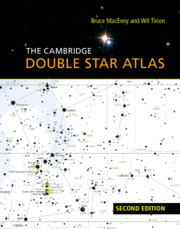Appendix A - The target list
Published online by Cambridge University Press: 05 May 2016
Summary
Two criteria were used to select the following 2,500 “high probability” double stars from the 110,950 unique systems in the January, 2015 Washington Double Star Catalog.
The first is visual limits to magnitude and resolution. With few exceptions, targets are only included down to a combined visual magnitude of 7.75 and secondary stars down to magnitude 13.5; separations are not less than the Abbe resolution limit of Ro = 0.5″ feasible with a 250 mm or larger objective. Over 90% of the pairs can be resolved with a 150 mm aperture.
The second is evidence of a physical bond. This includes a projected separation less than 5,000 AU, a divergence between proper motion vectors less than 30% of the larger proper motion, a note in WDS that the system is physical based on CPM and/or parallax data, or an orbital solution (weighted by the quality rating assigned in the 6th Catalog of Orbits of Visual Binary Stars). Negative indicators included a projected separation greater than 50,000 AU, a CPM deviation greater than 80%, a WDS flag indicating a “bogus binary” or optical pair, or a linear solution (a straight line path rather than curved orbital motion). Every record in WDS was evaluated against these criteria and the highest scoring systems and components (within the visual limits) were selected. These systems were further vetted using sky survey images at SIMBAD, observing notes and other references. Although this procedure cannot ensure every target is a physical system, it does reveal more accurately the true variety in physical double and multiple stars outside the traditional and ambiguous criterion of “looking like” a double star.
To conserve space, data are listed on a single line. This includes the Bayer, Flamsteed or Gould (southern hemisphere) designation, the catalog ID (as it appears in the charts); the component letter codes; the celestial coordinates for epoch J2000; magnitudes, position angle (θ) and separation (ρ) for the listed components; distance from the Sun (in parsecs); spectral types (with alternate or dual types, most special codes and giant subtypes omitted for simplicity), and the Henry Draper (HD) and Smithsonian (SAO) catalog numbers. Distances estimated by spectroscopic parallax are flagged with an asterisk (*).
- Type
- Chapter
- Information
- The Cambridge Double Star Atlas , pp. 85 - 164Publisher: Cambridge University PressPrint publication year: 2015



